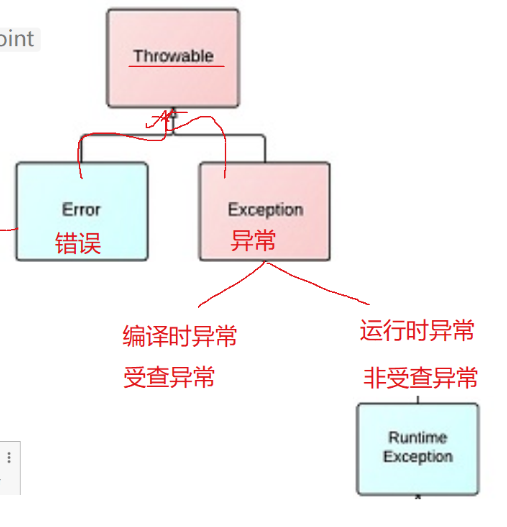异常
异常
1. 异常体系结构

public class Test {
public static void func() {
func();
}
// 错误
public static void main2(String[] args) {
func();
}
// 运行时异常
public static void main1(String[] args) {
System.out.println(10/0);
System.out.println("abc");
}
}class Person implements Cloneable {
public String name;
public int age;
public Person(String name, int age) {
this.name = name;
this.age = age;
}
@Override
protected Object clone() throws CloneNotSupportedException{
// 一定得在子类方法中, 调用protected修饰的父类成员
return super.clone();
}
}
public class Test {
public static void main(String[] args) /*throws CloneNotSupportedException*/ {
Person person1 = new Person("a",1);
// 报错 ! 编译时异常
Person p2 = (Person) person1.clone();
System.out.println(p2.name);
}
}
2. throw 抛出异常 / throws 声明异常
我们自己用throw 关键字 抛出的异常。一般情况下,用throw抛出自定义异常
public class Test {
public static void func() {
// 自己手动抛出异常
throw new NullPointerException("test");
}
public static void main(String[] args) {
func();
}
}throw 细节:
- throw必须写在方法体内部
- 抛出的对象必须是Exception 或者 Exception 的子类对象
- 如果抛出的是 RunTimeException 或者 RunTimeException 的子类,则可以不用处理,直接交给JVM来处理
- 如果抛出的是编译时异常,用户必须处理,否则无法通过编译
- 异常一旦抛出,其后的代码就不会执行
throws 声明异常
throws必须跟在方法的参数列表之后
class Person implements Cloneable {
public String name;
public int age;
public Person(String name, int age) {
this.name = name;
this.age = age;
}
@Override
protected Object clone() throws CloneNotSupportedException{
// 一定得在子类方法中, 调用protected修饰的父类成员
return super.clone();
}
}
public class Test {
// throws 只是声明异常 并不处理异常, 在这里例子中 throws CloneNotSupportedException
// 告诉main函数的调用者, 在main方法内部有个 CloneNotSupportedException异常, 需要去处理
// 如果程序的异常没有被程序员处理, 那么这个异常就会交给 JVM 处理, 程序立即停止执行
public static void main(String[] args) throws CloneNotSupportedException {
Person person1 = new Person("a",1);
// 报错 ! 编译时异常
Person p2 = (Person) person1.clone();
System.out.println(p2.name);
}
}
3. 处理异常
try - catch

public class Test {
public static void func() throws NullPointerException {
throw new NullPointerException();
}
public static void main(String[] args) {
try {
func();
}catch (NullPointerException e) {
// 打印异常信息
e.printStackTrace();
System.out.println("捕获到空指针异常");
}
}
}
finally
用来对资源进行回收
import java.util.Scanner;
public class Test {
public static void main(String[] args) {
Scanner scanner = new Scanner(System.in);
try {
int a = scanner.nextInt();
int[] arr = {1,2,3};
System.out.println(arr[3]);
}catch (NullPointerException e){
System.out.println("捕捉空指针异常");
}catch (ArrayIndexOutOfBoundsException e) {
System.out.println("捕捉数组越界异常");
} finally {
// 释放资源
System.out.println("执行finally");
scanner.close();
}
}
}
finally在最后一定会被执行
import java.util.InputMismatchException;
import java.util.Scanner;
public class Test {
public static int func2() {
Scanner scanner = new Scanner(System.in);
try {
int a = scanner.nextInt();
return a;
}catch (InputMismatchException e) {
e.printStackTrace();
System.out.println("捕获InputMismatchException异常.....");
}finally {
System.out.println("finally被执行了...");
scanner.close();
return 99;
}
}
public static void main(String[] args) {
System.out.println(func2());
}
}






 浙公网安备 33010602011771号
浙公网安备 33010602011771号